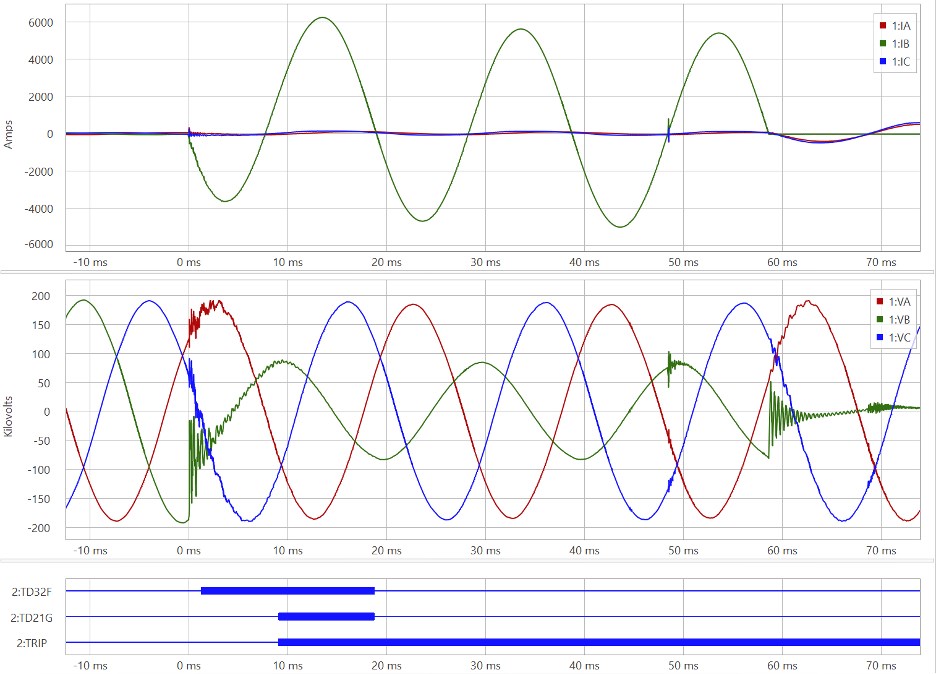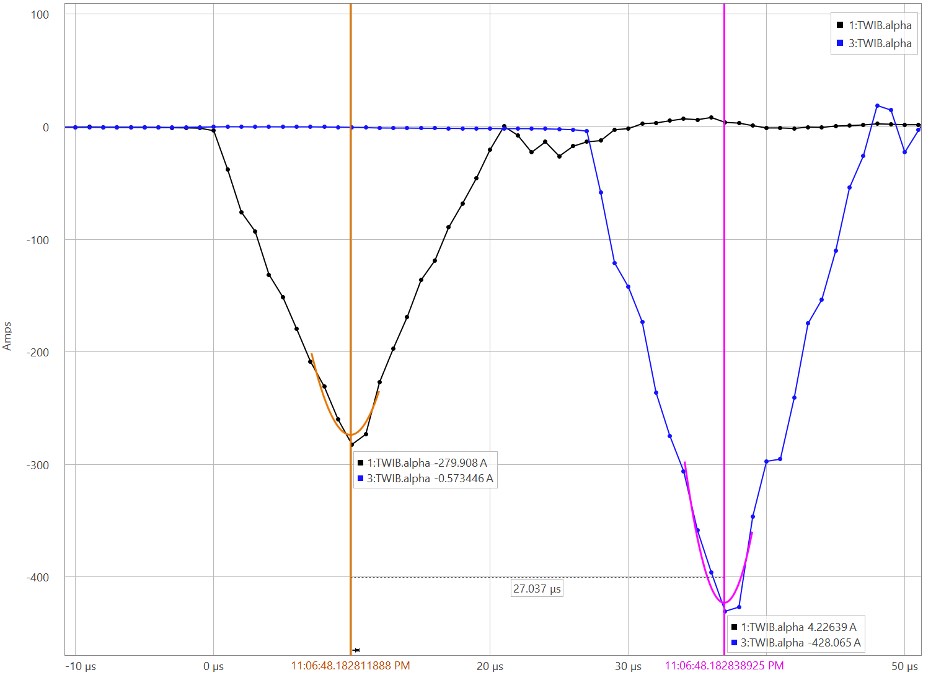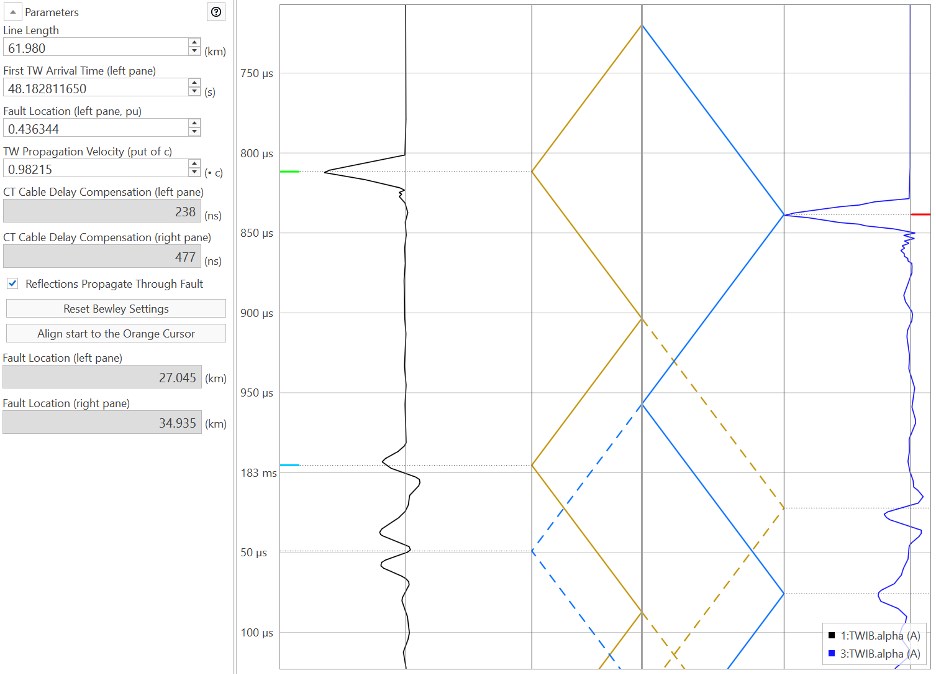Field Experience With Traveling-Wave Protection and Fault Locating
COMED uses SE-TWFL to pin down fault location
On July 19, 2020, the SEL-T400L Time-Domain Line Protection detected a C-phase-to-ground fault while monitoring a 56.62 mi (91.12 km), 345 kV transmission line between two terminals (referred to as Terminals S and R) on the ComEd system. The SEL-T400L was installed at Terminal S.Figure 1 shows the voltage and current signals sampled at 1 MHz captured by the SEL-T400L. The single-ended traveling-wave-based fault locator (SE-TWFL) reported the fault location to be 49.266 mi (87.011 percent of the line length) from Terminal S. The traveling-wave directional (TW32) protection element declared the fault in the forward direction in 104 µs, and the incremental-quantity directional (TD32) protection element declared the fault in the forward direction in 1.3 ms. The incremental-quantity distance (TD21) protection element, which was set with a reach of 70 percent of the total line length, correctly restrained.Commonwealth Edison Company (ComEd) provides electric service to more than 4 million customers across northern Illinois, or 70 percent of the state’s population. ComEd is a subsidiary of Exelon Corporation, a leading competitive energy supplier.
NamPower—Dual relays operate for internal fault on 220 kv line in under 1.1 milliseconds
Frans Shanyata of NamPower observes, “There is no doubt from the captured event that this is the fastest protective device in the world.”On February 4, 2020, a pair of SEL-T400L Time-Domain Line Protection relays detected a C-phase-to-ground fault while monitoring the 70.59 mi (113.6 km), 220 kV overhead transmission line from the Khan to Omburu substations, near Omaruru, Namibia. In addition to the SEL-T400L relays, NamPower applies SEL-311L Line Current Differential Protection and Automation System relays at each terminal that also detected the fault. Figure 1 shows the voltage and current signals sampled at 1 MHz captured by the SEL-T400L at the Omburu substation. It also shows the performance of the SEL-T400L and SEL-311L elements and schemes.Red Eléctrica de España Uses Bewley Diagram in Synchrowave Event Software to Obtain DE-TWFL Results
On December 8, 2019, a pair of SEL-T400L Time-Domain Line Protection relays detected an internal B-phase-to-ground fault while monitoring the 61.98 km (38.51 mi), 220 kV, 50 Hz Red Eléctrica de España (REE) overhead transmission line between the Casaquemada and Onuba terminals.
Relay-to-relay communications were not in place, making the double-ended traveling-wave (TW)-based fault location (DE-TWFL) results unavailable for automatic calculation by the relays. However, both relays were connected to a high-accuracy IRIG-B time source. Since the relays were synchronized to absolute time, the DE-TWFL results could be obtained using the Bewley diagram feature in SEL-5601-2 Synchrowave Event Software.
For this event, the DE-TWFL result was determined to be 27.045 km from the Casaquemada terminal. This was corroborated by the single-ended impedance-based fault location (SE-ZFL) and single-ended TW-based fault location (SE-TWFL) results, which were 24.220 km and 26.728 km, respectively.
The event report data in Figure 1 was used to evaluate the SEL-T400L line protection, which uses elements and schemes based on incremental quantities and TWs. Figure 1 shows the voltage and current signals sampled at 1 MHz by the SEL-T400L at the Casaquemada terminal. The figure also shows the performance of the incremental-quantity directional forward (TD32F) element and incremental-quantity ground distance (TD21G) element, which operated in 1.29 ms and 9.09 ms, respectively. In the SEL-T400L at the Onuba terminal, TD32F and TD21G elements operated in 1.29 ms and 9.69 ms, respectively.

Figure 1 – Casaquemada SEL-T400L event report data showing B-phase fault.
SEL-T400L event reports also contain fault location results for all four methods, including up to four possible SE-TWFL results. Figure 2 shows the fault location results from the SEL-T400L at Casaquemada, and Figure 3 shows the results from the SEL-T400L at Onuba.
[Fault_Location]
SE_TW_Location1,"26.728(km)"
SE_TW_Location2,"33.168(km)"
SE_TW_Location3,"$$$$$$$(km)"
SE_TW_Location4,"$$$$$$$(km)"
DE_TW_Location,"$$$$$$$(km)"
SE_Z-Based_Location,"24.220(km)"
DE_Z-Based_Location,"$$$$$$$(km)"
First_TW_Time_Local,"2019/12/08,05:06:48.182811650"
Figure 2 – SEL-T400L fault location results at Casaquemada
[Fault_Location]
SE_TW_Location1,"3.158(km)"
SE_TW_Location2,"27.738(km)"
SE_TW_Location3,"34.755(km)"
SE_TW_Location4,"38.668(km)"
DE_TW_Location,"$$$$$$$(km)"
SE_Z-Based_Location,"32.081(km)"
DE_Z-Based_Location,"$$$$$$$(km)"
First_TW_Time_Local,"2019/12/08,05:06:48.182838448"
Figure 3 – SEL-T400L fault location results at Onuba.
Since DE-TWFL results were not available for automatic calculation by the relays, REE chose to calculate the results manually using data available in the time-synchronized event reports from both terminals. The “First_TW_Time_Local” value in Figures 2 and 3 indicates the arrival time of the initial TW at each end. These arrival times are compensated for the cable delay between the CTs and the relay. This compensation is performed by back-dating the time stamps through use of the relay settings for CT cable propagation time (TWCPT).
Comparing the “First_TW_Time_Local” value in Figures 2 and 3 shows that the SEL-T400L at Casaquemada was the first to see a TW, which indicates the fault was closer to that terminal. Furthermore, the first TW arrived at Casaquemada 26.798 µs before the first TW arrived at Onuba.
Using the equation in (1), including the arrival time difference (Δt) and relay settings for the line length and traveling-wave line propagation time (LL and TWLPT, respectively), REE calculated the DE-TWFL result to be 27.045 km from Casaquemada. Note that Δt is negative in (1) because the fault was closer to Casaquemada.

Similarly, REE used the equation in (1) to calculate the fault location from the Onuba terminal. Since the fault was closer to Casaquemada, Δt is a positive number when performing the calculation with respect to Onuba, and the result is 34.935 km.
Figure 4 shows the TWs captured by the SEL-T400L relays at Casaquemada (black) and Onuba (blue) and displays the relative arrival time difference between the TWs at each end. The arrival time difference in Figure 4 (–27.037 µs) differs from the value determined previously (–26.798 µs) because it does not compensate for CT cable delay (TWCPT setting in each relay). When compensation for TWCPT is applied to Figure 4, the same arrival time difference is obtained: –27.037 – (0.238 – 0.477) µs = –26.798 µs. Figure 4 also shows that both TWs are in phase (i.e., both have negative polarity), as we expect for an internal (on-the-line) event or fault.

Figure 4 – SEL-T400L oscillograph data showing B-phase Casaquemada (black) and Onuba (blue) TWs.
The Bewley diagram in Figure 5 shows the time and distance relationship of the measured B-phase alpha-mode TW currents for the Casaquemada (black) and Onuba (blue) terminals with subsequent reflections. The fault location provided by the software matches the result of the manual calculations using the equation in (1).

Figure 5 – Bewley diagram showing the measured B-phase alpha-mode TW currents for the Casaquemada (black) and Onuba (blue) terminals.
The offline DE-TWFL results calculated by REE differed from the SE-TWFL results in Figures 2 and 3 by 317 m (1,040 ft) and 180 m (591 ft), respectively. The SE-TWFL and SE-ZFL results corroborated the DE-TWFL results REE obtained from the Bewley diagram in Synchrowave Event and by manual calculation.
Armed with the results of this analysis, REE’s maintenance team inspected the circuit and found evidence of the fault at a tower located 26.942 km from Casaquemada (35.009 km from Onuba). Identification of the true fault location confirmed that the results obtained from the Bewley diagram in Synchrowave Event and from manual calculation of the DE-TWFL were within one tower span from either end: 103 m from Casaquemada and 74 m from Onuba.
Please continue to send user experiences and events related to this technology, or requests for more-detailed information, to TD_Support@selinc.com.
For more details about these specific projects, contact Product Engineer Greg Smelich.
About REE
Red Eléctrica de España is the transmission grid owner and operator for the transmission system in Spain. With more than 44,000 km of high-voltage transmission lines, REE is responsible for ensuring the proper operation of the Spanish electrical system, coordinating the generation transport system and planning the long-term growth of the transmission network to provide secure and continuous power supply to the country.
Petroeléctrica de los Llanos (PEL) benefits from the excellent performance of the SEL-T400L relays
On August 1, 2019, a pair of SEL-T400L Time-Domain Line Protection relays detected a C-phase-to-ground fault while monitoring the 153.2 km (95.2 mi) 230 kV PEL transmission line from Jagüey to Quifa. This line is part of the 260 km (161.6 mi) 230 kV PEL transmission corridor from Chivor to Rubiales in Northeast Colombia, shown in Figure 1. The fault was induced by lightning that caused an insulator flashover.Single-ended traveling-wave-based fault locator in SEL-T400L pinpoints location of fault induced by sUAS
On June 21, 2019, an SEL-T400L Time-Domain Line Protection detected a C-phase-to-A-phase fault while monitoring a 16.6 km, 115 kV transmission line from Puebla Dos to Amozoc, northeast of Puebla, Mexico. The fault was induced by a small unmanned aerial system (sUAS), commonly known as a drone.The event report in Figure 1 shows the voltage and current signals (sampled at 1 MHz) recorded by the SEL-T400L at the Puebla Dos terminal. Figure 1 also shows the performance of the incremental-quantity distance (TD21) protection element, which operated in less than 3.5 ms (assertion of the TD21CA Relay Word bit).SEL-T400L Field Report: Forest Fire in Colombia Initiates B-Phase-to-Ground Fault
CELSIA, an electric company that operates in Colombia, Panama, and Costa Rica, reported that a forest fire caused a B-phase-to-ground short-circuit fault on a 115 kV transmission line. CELSIA had installed two SEL-T400L Time-Domain Line Protection devices on the 64.34 km (39.97 mi) transmission line with point-to-point fiber-optic communications between the two substations. The transmission line crosses the Colombian forest, and it often takes weeks to locate faults in the remote, fire-prone forest, so CELSIA hoped the SEL-T400L devices would help pinpoint fault locations. CELSIA wanted to verify the accuracy of the fault-locating method and also test the innovative SEL-T400L time-domain and traveling-wave protection functions to analyze their performance versus traditional protection.On September 11, 2018, a forest fire burned through a 13.2 kV distribution line wooden pole near a 115 kV transmission line. The downed pole caused the extra sag distribution line span that crossed under the transmission line to be pulled tight under the additional tension. When the normally extra sagging distribution line span was raised under tension by the downed pole in an adjacent span, the distribution conductors came too close to the transmission line above, resulting in a B-phase-to-ground fault on the transmission line. The fault was promptly detected by the two SEL-T400L devices, which then operated. Local inhabitants reported observing explosions at the fault location caused by the arcing intercircuit fault between the live distribution and transmission circuits.SEL-T400L Traveling-Wave Differential Scheme Operates in Less Than a Millisecond
On July 20, 2018, SEL-T400L Time-Domain Line Protection installed on an 8.49-mile, 69 kV transmission line in Arizona operated for a human-induced internal C-phase-to-ground fault. The fault was caused by a foil balloon melting across the C-phase wood-pole-mounted insulator, from the phase conductor to the bare pole ground conductor.External Fault Validates Security of SEL-T400L Protection Schemes
On July 9, 2018, an electric utility in New Mexico, USA, reported a fault behind the east terminal of a 345 kV, 33.1 mi transmission line. This fault triggered event reports in the SEL-T400L Time-Domain Line Protection devices protecting the line. These devices are applied with traveling-wave differential (TW87), incremental-quantity distance (TD21), and permissive overreaching transfer trip (POTT) schemes enabled to trip the circuit breakers. The directional elements in the SEL-T400L at the east terminal declared a reverse fault, restraining the operation of the POTT scheme. The TW87 scheme and underreaching distance element were also restrained for this external fault.Figure 1 shows the captured oscillographic data at the east terminal. The directional elements, TW32 and TD32, reported a reverse fault.SEL-T400L POTT Scheme Operates in 1.3 ms When Lightning Strikes a Transmission Line in Hawaii
On April 15, 2018, the SEL-T400L Time-Domain Line Protection devices monitoring a 16.75-mile transmission line in Hawaii detected an internal three-phase fault caused by a lightning strike. Each terminal of the line has an SEL-T400L and an SEL-311L Line Current Differential Protection and Automation System, with the protection systems sharing a single direct-fiber channel using wavelength division multiplexer (WDM) couplers. Figure 1 shows the passive WDM couplers where the two wavelengths, 1,550 nm and 1,310 nm, are multiplexed on the transmitted path and demultiplexed on the receiving path. The WDM approach allows the SEL-311L data exchange to coexist with the real-time sharing of the 1 MHz data required by the traveling-wave differential scheme and double-ended fault-locating functions in SEL-T400L devices.SEL-T400L Operates in 2 ms on a 161 kV Transmission Line
In April and May of 2018, the SEL-T400L Time-Domain Line Protection showcased its speed for detecting internal faults on a 72.8 mile, 161 kV transmission line in Idaho. The SEL-T400L installed at one of the terminals recorded four line-to-ground faults. The average operating time of the ground time-domain distance element (TD21G) was 1.59 milliseconds—less than 1/8 of a power system cycle at 60 Hz!The first event is shown in Figure 1. This is a Phase-C-to-ground fault for which the directional elements, TW32 and TD32, asserted in 115 µs and 1.12 ms, respectively. The SEL-T400L made a trip decision based on the TD21G element in 1.62 ms—this is before the fault current even gets halfway to the first peak!SEL-T400L Successful Operation for a Challenging Evolving Fault
On December 13, 2017, SEL-T400L Time-Domain Line Protection devices installed in a permissive overreaching transfer trip (POTT) scheme on a 230 kV, 28.4 km transmission line in Central America selectively tripped Pole C for an internal C-phase-to-ground fault. The SEL-T400L devices then tripped Poles A and B when the scheme detected a subsequent internal C-phase-to-A-phase-to-ground fault with Pole C already open.This sound multiple-pole tripping performance demonstrates the flawless operation of the SEL-T400L protection scheme for two separate faults that occurred less than 155 ms apart.First SEL-T400L Operation in Central America!
On December 8, 2017, SEL-T400L Time-Domain Line Protection devices installed on a 230 kV, 28.4 km transmission line in Central America tripped for an internal C-phase-to-ground fault, marking the first successful field operation of the SEL-T400L in Central America.SEL’s time-domain protection and fault-locating technology is exceptional. The TW87 protection scheme in the remote SEL-T400L operated in 1.01 ms. At the local end, the TW87 scheme operated in 1.08 ms. You can view the TW87 scheme operating times in Figure 1 below. The local directional elements, TW32 and TD32, asserted in 0.11 ms and 2.11 ms, respectively.Traveling-Wave Differential Operation on a 115 kV Transmission Line
SEL-T400L Time-Domain Line Protection devices installed on a 115 kV transmission line in Maryland operated for an internal A-phase-to-ground fault last month. The SEL-T400L fault locator reported the location as just over 2 feet from the actual fault location. In this event, the TW87 protection scheme operated in 1.03 ms and the Zone 1 underreaching distance (TD21) element operated in 6 ms. Figure 1 shows the voltages and currents captured by the SEL-T400L along with the protection elements.Seeing the Power System With New Eyes: Real-World Event Reports From the SEL-T400L
Dear SEL customers and friends:It has been over a year since we introduced our ultra-high-speed transmission line protective relay—the SEL-T400L Time-Domain Line Protection—with highly accurate fault-locating technology and a one-megahertz sampling rate fault recorder. Many of you have installed the SEL-T400L in pilot installations and are sending us event reports triggered on various disturbances and faults. We appreciate your vested interest in exploring and adopting new technologies. I am happy to share that the performance of the SEL-T400L in these pilot installations is meeting and exceeding our expectations.This event below is from a 230 kV, 28.4 km transmission line where the SEL-T400L issued the trip command in one millisecond using a traveling-wave differential scheme (TW87)—this is unheard of! The traditional phasor-based distance relay operated in 20 ms for this event.Ed